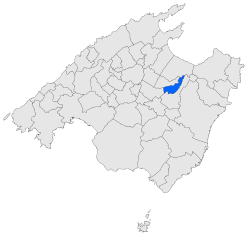Ariany, Spain
Nowadays, Ariany, Spain is a topic that has captured the attention of many people around the world. Whether due to its impact on daily life, its historical relevance or its influence on different sectors, Ariany, Spain has acquired significant importance today. From its origins to its evolution over time, Ariany, Spain has been the subject of study, debate and reflection by experts and fans alike. In this article, we will explore different aspects related to Ariany, Spain, analyzing its importance, its implications and its relevance in today's society.
This article needs additional citations for verification. (May 2024) |
Ariany
Ariañy | |
|---|---|
Municipality and town | |
 Parish Church of Nuestra Señora de Atocha | |
 Municipal location | |
| Coordinates: 39°38′58″N 3°6′39″E / 39.64944°N 3.11083°E | |
| Country | |
| Autonomous Community | Balearic Islands |
| Province | Balearic Islands |
| Island | Majorca |
| Comarca | Pla de Mallorca |
| Government | |
| • Mayor (2007-) | Joan Ribot Mayol |
| Area | |
• Total | 8.93 sq mi (23.14 km2) |
| Elevation | 407 ft (124 m) |
| Population (2018)[1] | |
• Total | 860 |
| • Density | 96/sq mi (37/km2) |
| Time zone | UTC+1 (CET) |
| • Summer (DST) | UTC+2 (CEST) |
| Website | http://www.ajariany.net |
Ariany (Catalan pronunciation: [əɾiˈaɲ]) is a small municipality on Majorca, one of the Balearic Islands, Spain. It has an area of 22.72 km ² with 839 inhabitants in 2008, 763 of which lived in the main town. In 2006, the foreign population of the municipality was 10.4% (80 people). Since 2007 the Mayor (Alcalde) has been Joan Ribot Mayol, re-elected in 2023. [2]
Situated in the Plain of Mallorca (Llano de Mallorca)[3] it is 50km from Palma, the island Capital, 6km from Petra[4] and 19km from Manacor.
History
Archeological findings show that the surrounding villages were present in prehistoric times. James I of Aragon first referred to the settlement with its current name. From the sixteenth century it was subject to the Cotoner family, owners of the land in Ariany. The current population center was developed around the manor house of the Auberg's, named S'Auberg i El Camí de Sa Marquesa. Other main buildings today include the Parish Church of Nuestra Señora de Atocha (built in 1570) and Ca ses Monges, the convent of Franciscan nuns.
References
- ^ Municipal Register of Spain 2018. National Statistics Institute.
- ^ "Benvinguts i benvingudes a la web de l´Ajuntament d'Ariany | Ajuntament d'Ariany". www.ajariany.net. Retrieved 2025-02-20.
- ^ "Llano de Mallorca", Wikipedia, la enciclopedia libre (in Spanish), 2024-06-15, retrieved 2025-02-20
- ^ "Petra (Baleares)", Wikipedia, la enciclopedia libre (in Spanish), 2025-01-08, retrieved 2025-02-20



